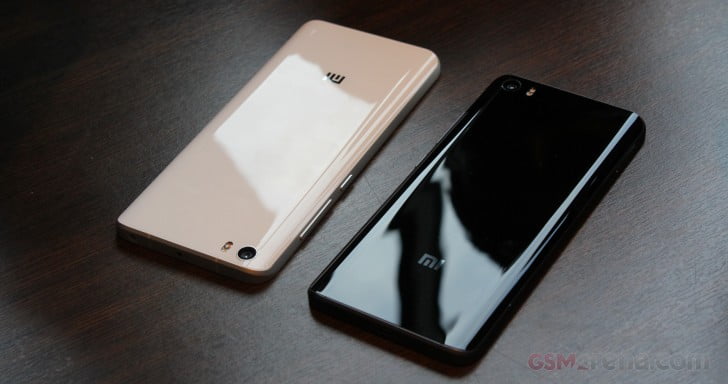The MWC 2016 welcomed another much-hyped flagship. Xiaomi VP Hugo Bara was the one to introduce the Mi 5 alongside a beefed-up 64GB model and the exclusive ceramic version called the Mi 5 Pro.

We also caught the Xiaomi Mi 4s, an upgrade of the popular Mi 4c.
The Xiaomi Mi 5 will be available in three different editions: the basic 32GB model, an enhanced 64GB flavor with faster processing, and an exclusive ceramic back edition with a whopping 128GB of storage, a more potent processor, and 4GB of RAM.
Xiaomi Mi 5 (32GB) at a glance:
- Form factor: Metal and glass body
- Screen: 5.15″ IPS 1080p display (428ppi)
- Camera: 16MP Sony IMX298 sensor, f/2.0, phase-detection AF, 4-axis optical image stabilization, pixel-to-pixel isolation; 4MP front camera with 2µm pixel size
- Chipset: Snapdragon 820: Kryo CPU @ 1.8 GHz, Adreno 530 @ 510MHz, 3GB RAM @ 1333MHz
- Storage: 32GB UFS 2.0
- Connectivity: Optional dual-SIM; LTE Cat.12; NF; Infrared blaster; USB Type-C connector
- Battery: 3,000 mAh; Quick Charge 3.0
- Software: Android 6.0 Marshmallow with MIUI 7.0

Xiaomi Mi 5 64GB edition over Xiaomi Mi 5 (32GB):
- Chipset: Snapdragon 820: Kryo CPU @ 2.15 GHz, Adreno 530 @ 624MHz, 3GB RAM @ 1866MHz
- Storage: 64GB UFS 2.0

Xiaomi Mi 5 Pro Edition over Xiaomi Mi 5 (32GB):
- Form factor: Metal and glass body, ceramic back
- Chipset: Snapdragon 820: Kryo CPU @ 2.15 GHz, Adreno 530 @ 624MHz, 4GB RAM @ 1866MHz
- Storage: 128GB UFS 2.0
Xiaomi Mi 5 hands-on
The Xiaomi Mi 5 looks like a properly refined Mi 4.
Xiaomi had the white flavor only of the glass/metal base version while the exclusive ceramic version will be sold in black only.
The Mi 5 may feature a bigger screen, a more powerful chipset, and better camera, but it managed to shed a good 20g off, for a total weight of the incredible 129g. The Mi 5 feels great in the hand, very lightweight, and yet extra solid.




Xiaomi Mi 5
The Xiaomi Mi 5 features a new 5.15″ IPS display of 1080p resolution. Even though most of the rumors suggested an upgrade to 2K resolution, Xiaomi chose to keep the Full HD screen, and we don’t mind that. A pixel density of 428ppi is more than respectable and leaves the Snapdragon 820 chip with power to spare on tasks and productivity.




Xiaomi Mi 5
The new display utilizes 16 LEDs on backlighting, allegedly four more than most of the present-day flagships, and Xiaomi claims it will provide more even backlighting at up to 600 nits of brightness. We can confirm the display is bright, quite bright indeed.




Xiaomi Mi 5
The viewing angles are very impressive as well, hardly any color shift or contrast loss when looking the Mi 5’s display at an angle.
The Mi 5 also has this Sunlight Display technology, which adjusts the contrast at pixel level. The results seem promising.




Xiaomi Mi 5
We have always appreciated metal frames in phones, and the Xiaomi Mi 5 delivers. It improves the grip, boosts the looks, and makes the handling more pleasant.
The display may look almost bezel-less, but it isn’t. The metal frame is the border, and it took us a while to get used to it when swiping, as most of the time our thumb scratched the metal before proceeding seamlessly on to the screen. It wasn’t unpleasant, but unusual at first.
The white version isn’t prone to smudges, but the black ceramic finish is a real fingerprint magnet. The ceramic looks stunning, though, and it will easily impress even the most demanding users.

The ceramic flavor actually weighs 10g more, but we couldn’t tell the difference. It may be heavier, but it’s still one of the lightest flagships we’ve handled so far.




Xiaomi Mi 5 next to the Xiaomi Mi 5 Pro
The fingerprint scanner below the display takes about 20 seconds to set up and instantly recognizes your finger from then on. Unfortunately, it isn’t always on, and you need to either click the home key or use the power button to wake up the screen before scanning your fingerprint in a split second.




The ceramic version of Xiaomi Mi 5
The Xiaomi Mi 5 is surely a stunner, as becomes a proper flagship.



Xiaomi Mi 5 Pro (a.k.a. the ceramic edition)
Rumor has it, the Mi 5 will probably be the first Xiaomi smartphone to be readily available internationally, and we’re looking forward to getting the details on that. Xiaomi didn’t have any official announcement to make at the time of writing.
Benchmarks
All three flavors of Xiaomi Mi 5 run on the Qualcomm’s latest and greatest Snapdragon 820 chip. The SoC features Qualcomm’s custom built quad-core Kryo CPU. Qualcomm promises up to 2x higher performance than the Snapdragon 810.

The GPU – Adreno 530 is more capable too, but we weren’t able to run dedicated benchmarks.
So, the basic 32GB model of the Mi 5 has two Kryo cores at 1.8GHz and two Kryo ticking at 1.6GHz. The 64GB and the ceramic flavors are utilizing 2x Kryo running on 2.15GHz and 2x Kryo at 1.6GHz. We managed to grab the more powerful 64GB model and here is how the new CPU stacks against the competition.
The multi-core performance has improved since the Snapdragon 810 chips (Nexus 6P) and matched the Exynos 7420 octa-core processor inside the Galaxy S6 edge+ and Meizu Pro 5. It also edged Apple’s latest A9 chip.
Camera
The camera setup in the Xiaomi Mi 5 uses a 16MP sensor with an f/2.0 aperture and 4-axis optical image stabilization – a brand new technology. The sensor itself is the Sony IMX 298, which comes with phase detection auto focus and deep trench isolation technology.

The sensor seems like the real flagship deal, at least on paper and, interestingly enough, Xiaomi managed to fit it inside the body without a lens bump. Naturally, in combination with the powerful Snapdragon 820 chip, it can do 4K video as well.
The rear camera is protected by a piece of sapphire glass.
On the front, we have a 4MP UltraPixel camera – lifted from the Mi Note.
We took a few shots after the Mi 5 event and, while its software is yet to be finalized, the images look promising. We’ll reserve our judgment for the retail unit.






Xiaomi Mi 5 camera sample
[Source:- Gsmarena]










